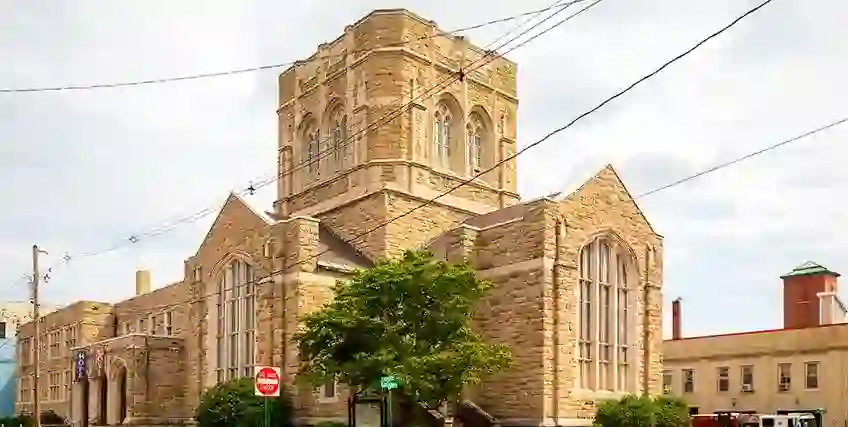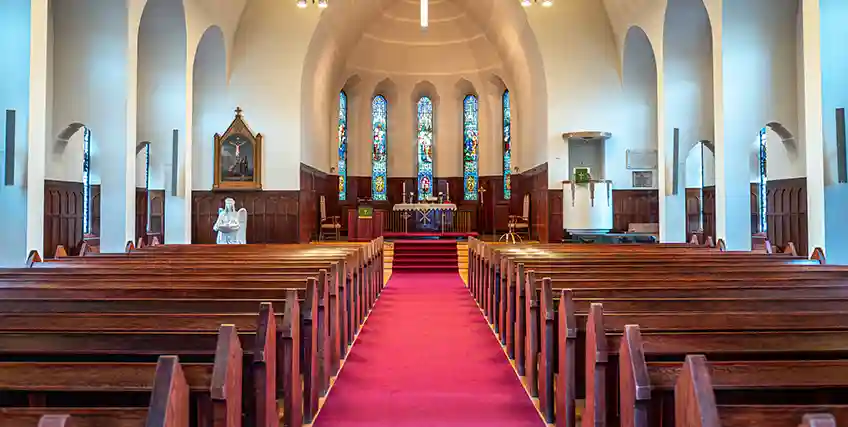Financing Church Renovations, Events, or Community Programs: What Are the Options?
May 20, 2025 | Last Updated on: May 21, 2025

Many of today’s churches face growing demands to modernize their facilities, expand their ministries, and serve broader community needs, all of which can cost significant money to accomplish. Whether it's updating an outdated infrastructure, creating new functional fellowship spaces, or building a larger worship center, church renovations often require a significant financial investment.
For many congregations, securing a loan for religious business is a practical way to fund these renovation projects, versus paying for them upfront and in cash. Keep reading to learn everything you need to know about church renovation loans, from understanding financing options to updated church design, project management options, and even working with the right partners.
Step 1: Assess the Scope and Cost of Your Church Renovations
Before you can begin to determine the type of funding that’s necessary for your church construction projects, you need to first decide what kind of church renovations will be done and to what extent. This allows you to get a broad idea of the project scope and at least decide the general ballpark of your funding needs.
What Type of Renovation or Remodelling is Needed?
Spend some time looking at both what your church needs and what you’d like your church to have, both inside and outside the building. These renovation and remodelling needs will vary from one church to the next, too. For example, a Catholic church may want to upgrade pew kneelers and add stained glass windows or a new organ, while a bustling community church may focus more on the worship space, children’s ministry resources, and a stage with concert lighting for the church band to play.
Depending on the size of your church, the type of building you already have, and your plans for the campus’ functionality moving forward, some church restoration and renovation ideas might include:
- Structural repairs
- Accessibility upgrades (like extended church pews, ramps, and elevators)
- Sanctuary upgrades (everything from new carpet and pew cushions to high quality theater seating)
- Small church remodelling to create multi-use spaces
- Building additions and other new construction projects
- Refreshing existing spaces with paint, a new roof, upgraded windows, etc.
- Unique installations such as murals, gardens, playgrounds, and more
- Improved signage
Establishing a clear scope will not only help you keep your eye on the end goal, but will also make sure everyone else knows what to expect. Roughly defining this from the outset — even if the scope and budget change a bit over time — will help ensure that the project can stay on track throughout the process.
Step 2: Partner with Church Renovation Companies Early
There are many design, architectural, and construction companies available today with specialized church renovation experience. Some of these even exclusively work with churches to help design, plan, and execute big church facility projects, whether you need someone else’s help with ideas or already have a clear vision for your church.
Look for licensed companies in your area early on in the process, ideally ones with many years of experience and church projects under their belts. Many of these companies have experience in sacred places as well as specific expertise in religious architecture. They can create renderings and show you examples of other projects they’ve worked on, so whether you’re renovating an old cathedral or worried about matching the craftsmanship of a hand-carved pulpit, they can help walk you through the renovation process.
Step 3: Lock in Your Estimate
The funding you’ll need for your church renovation depends heavily on the scope of your project. The cost of constructing a brand new church building and auditorium is a very different price point than if you’re just refinishing upholstery and installing new pews. So, getting multiple accurate estimates before obtaining funding and breaking ground is key.
While your project may not perfectly come in at or under budget in the end, outlining a rough cost ahead of time allows you to estimate your total expense and even find areas for cost savings. It also gives you time to get the church board, elders, etc. in agreement to move forward with the expansion or upgrades.
A good church loan calculator can help you play around with loan terms and expected interest rates and calculate the cost of financing over the long-term. Church loan rates will affect what you can afford to borrow today, as they will impact your monthly payment amount over the course of your repayment. The rates you’re offered will hinge on your business (and sometimes personal) credit history, down payment amount, project scope, how much you need to borrow, and the repayment term you choose.
Understanding Church Loan Options
Depending on how much you need to borrow for your renovation church loan, your borrowing options and funding sources may vary.
You may also want to stagger your funding options to support your church before, during, and after your renovation project. For example, this could mean taking out an initial church loan as a primary funding source for ongoing base costs, then supplementing extras with fundraising, grants, or another capital campaign.
Types of Loans for Churches
Funding to renovate a place of worship can come in the term of term loans, construction loans, and even bridge loans. All of these offer lump sum funding that can be used to pay for large church renovations, interior design projects, expansions, and more.
If you have equity in your property or other available assets, you can also refinance them to free up cash for renovations. The funds available through a refinance loan will depend on the types of assets you have, how much equity you have, and even how they’re owned.
Church Renovation Lenders
There are big benefits to working with lenders who primarily (or even exclusively) focus on religious organizations. This may include faith-based credit unions, nonprofit lenders, and even church extension funds (CEFs).
If you’re interested in something a bit more traditional, you can also look into standard business loan funding options for your church renovations, such as those available through local and online banks, credit unions, and specialized business lenders. Just know that many of these everyday lenders don’t offer loans to non-profit organizations, such as churches.
Preparing for Loan Approval
Anytime you want to borrow for a business or institution, including a church, preparing for that loan ahead of time can help ensure you’ll get approved. It will also better your chances of getting offered the most competitive loans terms for your situation, such as the lowest possible church loan rate, smallest down payment requirement, and the fastest approval.
Prepare Documentation
Before you even begin submitting applications to lenders for your church renovation loan, spend some time preparing and gathering the documents that will be required by most of those lenders. This will often include things like:
- Income statements (for the church and, in some instances, personal)
- Bank statements
- Previous years’ tax returns
- Budget forecasts
- Congregation attendance records and trends
- Board approvals for the project and scope
- Project plans, renderings, and expected expenses
- Your church’s tax ID number, also known as an employer identification number (EIN)
By putting these together ahead of time, you’ll not only save yourself time and speed along a potential loan approval, but also avoid the headache of sifting through accounts and files on the spot.
Show Financial Health
Lenders will usually want you to show evidence of your church’s current and continued financial stability, as well, to prove that it won't have an issue repaying whatever is borrowed today.
Final Thoughts
Church renovations will be helpful or even inevitable over time, whether you simply want to update your building, make repairs, or are forced to expand to support a growing congregation. Those changes and updates can be extremely costly, however, leading many wise church leaders to turn to church renovation loans. Rather than tying up church liquidity or limiting a project’s scope, church loans give you access to the capital you need to repair, renovate, or grow. And with proper planning, expert partners, and smart financing, church renovations can enhance and grow both your ministry and your overall community mission.
FAQs About Church Renovations
Can I get a grant for my church renovations?
There are limited grants available to churches that can help pay for at least a portion of your church renovations, usually without the requirement to pay back those funds. Many of these grants are specifically earmarked to help restore and preserve historical buildings and other places of worship. Some grants are limited to specific religious affiliations or regions, so be sure to check around for local, state, and national options for which your church may qualify.
Do banks lend to churches?
Many banks do indeed lend to churches, though you’re likely to find that the loan limits, eligibility requirements, funding timelines, and project limitations may be different than with other forms of business loans. For instance, equipment financing or real estate loans available to churches may offer higher loan limits or easier eligibility, especially since they are secured with collateral assets.
Can a church get an SBA loan?
Non-profits and select religious organizations like churches can be eligible for loans backed by the Small Business Administration (SBA), which often provide larger loan limits and competitive interest rates compared to commercial business loans. Whether or not your church qualifies for SBA-backed funding depends on the specifics of your organization, so be sure to check with the SBA and any potential lenders to see if you qualify.
Can a church get an equity loan?
Churches may be able to take out equity loans if they own certain property that has equity and is eligible to be used as collateral. For example, you may be able to take out an equity loan against existing church buildings or owned property in order to fund church renovations, like the addition of another building on your campus.
Does a church have an EIN?
Churches are required to get an EIN through the IRS, the same as any other business organization. This is not the same as the church’s tax-exempt number, so that will need to be obtained separately. Your church EIN will be used for tax returns, applying for funding, and more.




